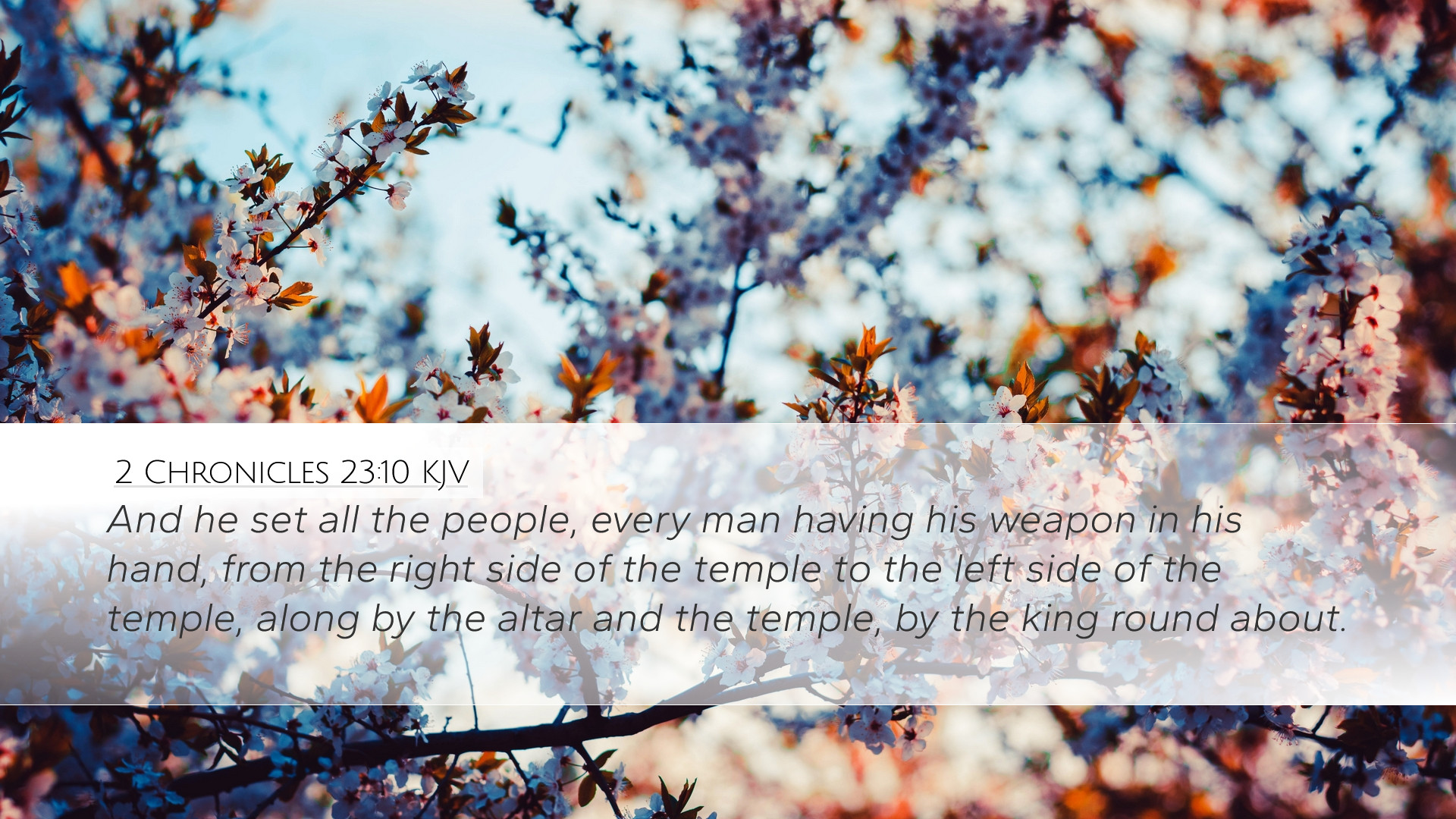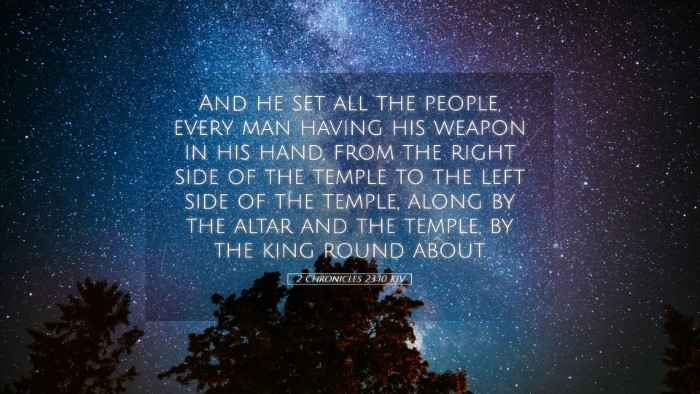Commentary on 2 Chronicles 23:10
2 Chronicles 23:10 states: “And he set all the people, every man having his weapon in his hand, from the right side of the temple to the left side of the temple, along by the altar and the temple.” This pivotal moment showcases critical themes in the biblical narrative, emphasizing divine providence, leadership, and the mobilization of faith in action. This commentary synthesizes insights from Matthew Henry, Albert Barnes, and Adam Clarke to explore these themes in depth.
Contextual Analysis
This verse falls within the dramatic account of the reign of Joash, the child king of Judah. The context, marked by tension and the need for restoration, reveals the actions of Jehoiada the priest, who orchestrates a coup against Athaliah, the usurper queen. Understanding this background is vital for comprehending the significance of the people's readiness for battle.
- Historical Context:
Joash, hidden from Athaliah’s massacre of the royal lineage, had been protected and raised by Jehoiada. Athaliah’s reign had brought idolatry and moral decay, and this moment signals a turning point for the restoration of true worship and national identity.
- The Character of Jehoiada:
Jehoiada emerges as a key figure, embodying the qualities of faithfulness and strategic leadership. He acts decisively to rally the people and restore the Davidic line, showcasing the interplay of divine providence and human agency.
Theological Themes
Several theological themes arise from this passage, which are crucial for both theological study and practical ministry.
- Divine Providence:
God’s hand is evident throughout this narrative, as He preserves Joash and aligns the circumstances for this moment of deliverance. Each action taken here displays God's sovereign control over the situation, guiding His people even in times of uncertainty.
- Call to Action:
The assembly of armed men reflects both preparedness and unity among the people. This collective action underlines the necessity of being equipped for spiritual warfare, a theme echoed throughout scripture. It invites today’s believers to consider how they are collectively prepared to stand for righteousness.
- Leadership:
Jehoiada’s leadership exemplifies the qualities of a godly leader—courage, wisdom, and the ability to inspire others to action. His ability to mobilize the people indicates that true leadership involves rallying others around a common cause, especially in faithful service to God.
Interpretation from Commentators
Matthew Henry
Matthew Henry emphasizes the gravity of this moment, indicating that Jehoiada’s organization of armed men was not merely for physical defense but for the protection of true worship and the covenant community. He draws attention to the contrast between the faith-filled actions of the priests and the idolatry that had previously permeated Judah under Athaliah.
Albert Barnes
Albert Barnes provides insight into the symbolism inherent in the placement of the guards. The strategic positioning from “the right side of the temple to the left side of the temple” suggests a complete encirclement, representing God’s omnipresence and protection over His chosen people. Barnes further correlates this act of readiness with spiritual vigilance in the life of the Christian.
Adam Clarke
Adam Clarke points out the significance of the “weapons” that the people bore. He interprets these weapons not only as physical instruments of warfare but also as spiritual tools necessary for engaging in the struggles of faith. Clarke calls for believers to equip themselves similarly with the full armor of God, as detailed in Ephesians 6, readying themselves for the spiritual battles they face.
Practical Applications
In light of these insights, several applications can be made for contemporary faith communities:
- Equipping Believers:
Church leaders should focus on equipping their congregations for spiritual battles through teaching and discipleship that emphasizes both knowledge and action.
- Community Unity:
Fostering a spirit of unity and collective purpose within the church body aligns with the community depicted in this passage, where each member plays a vital role in the defense of their faith.
- Faithful Leadership:
The qualities seen in Jehoiada remind current leaders of the importance of guidance, integrity, and the pursuit of God’s purposes above personal ambition. Leaders are called to model faithfulness and encourage others in their journey toward restoration in Christ.
Conclusion
2 Chronicles 23:10 serves as a powerful reminder of God’s sovereign hand in the affairs of His people and the necessity of human action in response to divine calling. The insights drawn from Matthew Henry, Albert Barnes, and Adam Clarke illuminate the ongoing relevance of this passage for believers today. By understanding the historical context and theological significance, congregations can be better equipped to stand firm in their faith, embody collective action, and pursue godly leadership.


